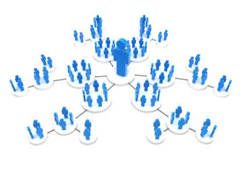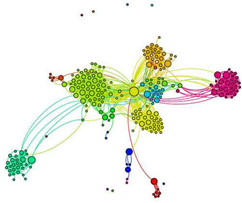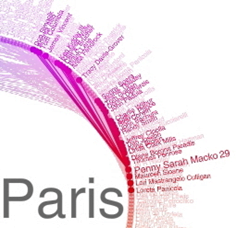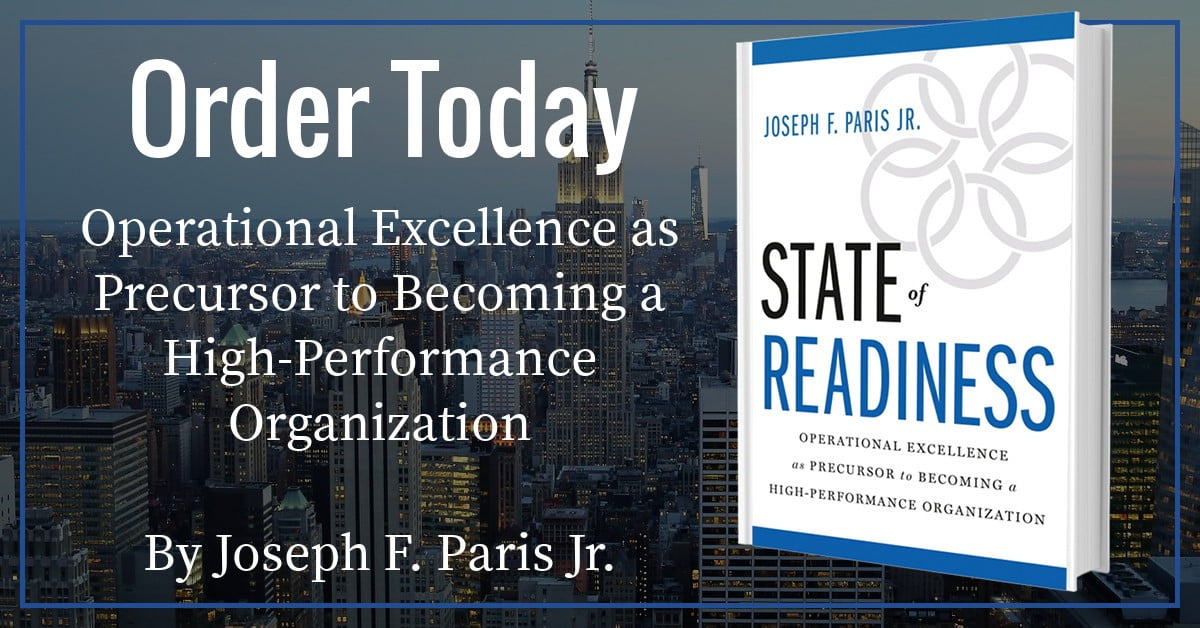“Guerilla Transformation” – Change an Insurgency into a Movement
Each of us belongs to a community, or network.
In fact, each of us belongs to a great many different networks – with each network being defined by some kernel at its core. These kernels may be physical, ideological, geographical, genetic, religious, or one of countless other characteristics that might define who we are and to what groups we might belong.
 For instance, each of us belongs to;
For instance, each of us belongs to;
– a “family” network, defined by those members of our respective families.
– a geographical network, defined by where we live.
– a political network, defined by “party affiliation”.
– even the readers of my articles constitute a network.
The individual members of a network have a shared commitment and affinity to the kernel and, as such, will behave in a predictable manner since there is nothing to gain by any individual changing their participation unilaterally. In reality, to disturb the predictability never even crosses the mind of the members.
Game Theory and the Nash Equilibrium:
In essence, a Nash Equilibrium exists – named after John Forbes Nash, who proposed it. A Nash Equilibrium basically states that each member of a network is supposed to know the natural objectives of the other members of the community, and no member is able to gain by deviating from a predicted behavior on their own. If all the members of a network share these common beliefs and no member of the network can gain an advantage by changing their behavior while the other members continue on as they always have, then the existing state perpetuates and constitutes a Nash Equilibrium.
 As the network grows, the dedication to the kernel persists and the beliefs shared by the members of the network become entrenched and are made increasingly unimpeachable – until they become inseparable and indistinguishable from the members of the network.
As the network grows, the dedication to the kernel persists and the beliefs shared by the members of the network become entrenched and are made increasingly unimpeachable – until they become inseparable and indistinguishable from the members of the network.
They, in fact, are requisite in defining the growing network – and establish a culture.
Still, a Nash Equilibrium persists because the members of the network see no individual benefit in changing their beliefs – or their tactics. Motivation to effect any change simply does not exist among the network members.
 As the network increases in size, eventually and naturally, factions (or sub-games) will come to exist within the network. These factions “localize” the core beliefs of the kernel so as to maintain the overall equilibrium, but permit some variants so as to increase the number and strength of the overall membership.
As the network increases in size, eventually and naturally, factions (or sub-games) will come to exist within the network. These factions “localize” the core beliefs of the kernel so as to maintain the overall equilibrium, but permit some variants so as to increase the number and strength of the overall membership.
These non-credible threats to the entire network help to maintain the overall equilibrium.
We can see real examples of this effect most obviously in the various factions and sects that can be found in:
– the world’s religions; for example Catholics and Protestants of Christian belief – or Shiites and Sunnis of Islamic belief.
– politics; for example in the United States – as in the “Blue Dogs” of the Democratic Party and the “Tea Party” within the Republicans.
– and a great many more.
Such variants exist to varying degrees of co-existence and cooperation. They can even directly compete and conflict with one another – but always rally together when an external threat manifests itself and threatens the community as a whole; for example the unprecedented political unity that occurred in the United States after 9/11. However, just as naturally and almost always, each faction will revert to the previous state once the threat has subsided. The Nash Equilibrium is thus maintained.
The same holds true in a business. A corporate culture – usually born of the company’s founder and largely perpetuated with minor changes over time – will be pervasive and remain unimpeachable. The Nash Equilibrium will ensure that the status-quo is maintained as there is no real motivation to change. That is, unless an external threat disrupts the equilibrium.
External Disruption:
Take International Business Machines (IBM) for example. Founded by Thomas Watson, a man of considerable will, he founded and grew the company largely along the lines of his vision and created a corporate culture which was unimpeachable. This served the company well until the then internally-grown leadership was faced with external threats for which they were ill-prepared and trained. These threats resulted in the near-collapse of the company in the early 1990’s until Lou Gerstner, an IBM outsider and CEO of RJR Nabisco was called upon to turn-around the fortunes of the company.
The many reforms and restructuring introduced by Gerstner were possible only because he had no past as an IBM’er – the fact that he had previously made Oreo’s and had no history in the technology industry at all was his strength. He was able to evaluate the many problems at IBM objectively, pragmatically and without emotion. That gave him the freedom and ability to redefine, and then re-align, the entire company.
The Tsunami of Change;
Each community, each company, has its threats with which it must deal. Most are non-credible threats and fail to disrupt the Nash Equilibrium. But some threats are significant enough to present a potentially catastrophic result to the network should they go unrecognized and unaddressed.
Like a Tsunami in the deep ocean, one can hardly notice the threat at all. In 2004, a Tsunami resulted from an earthquake off the coast of Sumatra, Indonesia. A person sitting in a row-boat in the middle of the Indian Ocean would not notice as the wave and its destructive energy passed beneath. However, the destructive power of the wave made was made known as the wave approached land and its energy compacted. At this point, it is too late to do anything except endure and recover.
Such is with business – when the threats are known and distant, the amount of energy and effort to prepare, react and repair is miniscule as compared to waiting too long.
So why do people wait too long to change? How might we be able to engineer and introduce a disrupter internally?
Internal Disruption:
A business and its culture will not change without a disruptor. And an external disruptor thrust upon a business will be traumatic in its form and response. But what if a disruptor can be engineered and introduced from within the business? Unfortunately, the Nash Equilibrium states that such will not ever be the case. This means that some event from outside the business-proper must be introduced for a disruption to occur.
Such event(s) can include; the hiring of a new “C-Level” executive, the merger of two businesses, the introduction of new financial partners, the hiring of consultants or other subject matter experts from outside the company, etc… As in the case of IBM in the 1990’s (and even the banking and automotive industry recently) I find it amazing how fast a company can begin (and even complete) the transformation process once an external catalyst is introduced.
So the key is to purposefully engineer and introduce an external disruptor such that the process of transformational change can begin with a small number of participants (an insurgency) and slowly, methodically, continuously and diliberately convert additional members of the business network to the new way – in effect, get them to “defect” from their old culture and instill in them the new culture.
It is important to be able to target the disruptor (so as to be most effective) and modulate the speed at which the disruption occurs (so that it does not get beyond control or the ability to support.)
As an illustration, let’s examine my personal network and how a disruptor might be engineered and introduced.
 This graphic is my Facebook “Friend Wheel” which represents my entire personal network on Facebook. This, in essense, is the “community of Joseph Paris”.
This graphic is my Facebook “Friend Wheel” which represents my entire personal network on Facebook. This, in essense, is the “community of Joseph Paris”.
In this wheel, the most inter-connected members of my network are represented on the top of the wheel (you can observe the number of lines representing the individual connections) and the least inter-connected members of my network are on the bottom of the wheel. In fact, some are not connected to any others on the wheel.
Based upon my experience, I can attest that all of the participants behave in a manner consistant with there being a Nash Equilibrium. If I take a look at any individual and their actions – regardless of their diverse backgrounds and beliefs – I can predict with confidence (if not certainty) how each will react to a circumstance presented; whether a news posting, or opinion, or image. There is no motivation to change or be changed.
 So if I wanted to effect true transformational change in my network, and not having infinite resources (as would also be in a business situation), I would want to engineer any disruptor so that it caused the greatest number of defects from their native state of being to my desired state of being.
So if I wanted to effect true transformational change in my network, and not having infinite resources (as would also be in a business situation), I would want to engineer any disruptor so that it caused the greatest number of defects from their native state of being to my desired state of being.
I would therefore not expend my resources trying to engineer and convert Ralph Talmont, whom I have known for almost two years and who is only connected to a single other connection in my network – even if he were inclined to defect. The follow-on benefit is just too little.
Two of the risks of an improperly engineered and introduced disruptor is that it is oversold and introduced too wide, too quickly.
– With respect to oversold; we have all heard of leaders stating grand plans and initiatives, only to fail on the delivery and cause themselves discredit. This condition can be readily observed in politics – in the many promises made on the campaign trail, and broken once elected.
– And with respect to too wide and too quick; the risk is to introduce a grand plan with great fanfare, then get the network engaged but not be able to support effort and momentum such that it stalls and the defectors lose faith – becoming even more resistant than they were before.
 It is best to communicate the nature and form of the transformational change that is to take place in the business, but target an inclined and meaningful starting point. In a network, the more connections a person has, the more inclined they are to share the core beliefs of the network – and the more credibility they will have to facilitate change.
It is best to communicate the nature and form of the transformational change that is to take place in the business, but target an inclined and meaningful starting point. In a network, the more connections a person has, the more inclined they are to share the core beliefs of the network – and the more credibility they will have to facilitate change.
In the example of my personal network, Penny Macko has 29 shared connections with me – and it is no coincidence that I have known her almost 40 years. She would be a perfect starting point for the introduction of transformational change.
Unfortunately, almost all “Continuous Improvement” (CI) inititiatives in companies are logistical in nature. They consist of a very few enthusiastic and talented individuals who are given very little in the form of resources or authority to successfully execute their mission. In most cases, they are set-up for failure, defined as; “having responsibility and accountability – but no authority.”
These “Continuous Improvement” professionals are forced to act like scrappy Hot-Dog Vendors – going from department to department trying to sell their CI “Hot-Dogs”. The customer has no real incentive to purchase the hot-dogs (they get no funding from corporate) – and are seen mostly as a cost, rather than a value.
We can almost imagine the conversation going like, “Would you like some 5S on your Kaizen? Maybe some VSM and DMAIC in a Pareto wrapper?”
The disrupter must be properly engineered and targeted, otherwise the gains will be marginal – if realized at all. A properly engineered disrupter will appeal to the target’s sensibilities and seduce them into defecting because it is truly in the target’s best interest – not someone else’s idea of what is in their best interest.
A few years ago, I was planning my annual trip to Southern Africa to visit my offices there and to do some brain-storming with the staff-members and partners. One of my friends in the States, an avowed feminist, wanted to go with me so that she could conduct workshops with some of the local women and help “liberate” them. Being a sensitive and avowed feminist myself (it’s true, ask anyone that knows me) I suggested that, instead of conducting workshops, she should build some wells in the villages as a convenient source of water.
She was aghast, but not entirely surprised at the callousness of my suggestion. But she wanted to help liberate these repressed women in Southern Africa and the best way to do that (in her mind) was to conduct workshops that would demonstrate a better way.
I informed her that the women in the rural villages of Southern Africa can spend up to five (5) hours a day fetching water (oftentimes even more), walking miles each way, every day, to the nearest (nearly) potable watersource.
I further explained that the easiest way to liberate a woman (or anyone, for that matter) is to give them time – especially a significant amount of time every day of the week. This had not dawned upon her – but she understood.
When engineering a disrupter, it is critically important to ensure the motivation to defect is seductive enough to the target so as to instill a sense of “want”. The best way to do this is to ensure that the Key Performance Indicators (KPI’s) are properly defined so they help facilitate the correct alignment of the target. To get someone to change, you can’t focus on the whole, you have to focus on the individual.
Change Agents are never loved and it’s not easy being one. It’s even harder to properly engineer, deploy and manage a strategic disrupter. But it’s far better to introduce your own disrupter and to effect the changes necessary to keep your business relevant than it is to react to someone else’s disruptor.
About the Author
 Joseph F Paris Jr is the Chairman of the XONITEK Group of Companies. With over twenty years as entrepreneur, academic and professional instructor, and strategic consultant – he is a champion of Operational Excellence (Lean Six-Sigma and Leadership) who has devoted himself to increasing stakeholder-value for his clients and constituents.
Joseph F Paris Jr is the Chairman of the XONITEK Group of Companies. With over twenty years as entrepreneur, academic and professional instructor, and strategic consultant – he is a champion of Operational Excellence (Lean Six-Sigma and Leadership) who has devoted himself to increasing stakeholder-value for his clients and constituents.
Contact him at parisjf@xonitek.com








